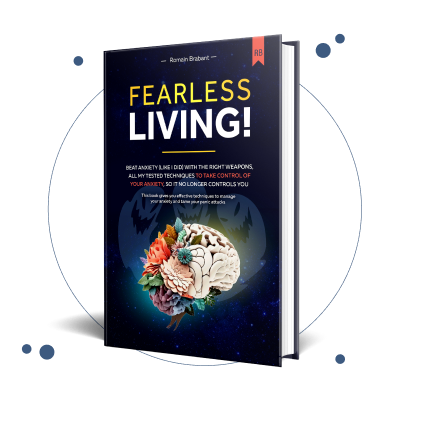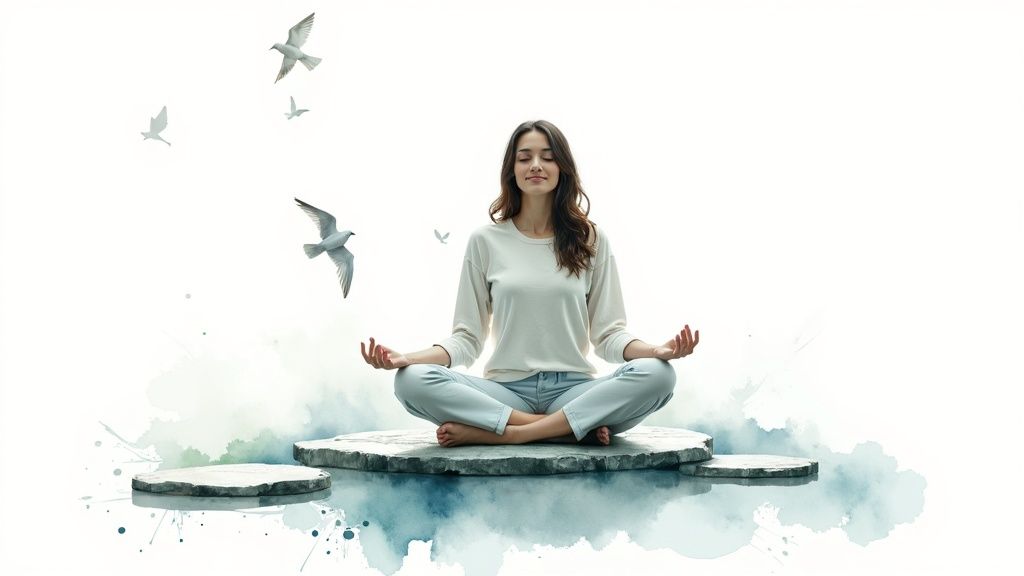
Feeling trapped by anxiety can be one of the most isolating experiences a person can go through. But I want to be clear about something right from the start: a life with less panic and more peace is not just a dream—it is entirely possible, even without medication.
This guide is built on a hopeful truth I've seen play out time and time again—you have the power to retrain your mind and calm your body. We're going to move beyond just 'coping' and into the territory of genuine, lasting healing. You can heal. You can live a life free from panic.
Your Path to a Panic-Free Life Is Possible
Successfully healing from anxiety naturally comes down to working on four key areas: rewiring anxious thought patterns, learning to regulate your body's stress response, building a supportive lifestyle, and connecting with the present moment. This isn't about some quick fix; it's about building a toolkit of skills that will serve you for a lifetime, leading you toward a future where you are in control.

If you're reading this, you know the feeling. The racing heart, the looping worries, the sense that you're just one stressful moment away from a full-blown panic attack. It's an exhausting way to live, and it’s completely understandable to wonder if you can ever feel "normal" again without relying on medication.
Let me tell you with complete certainty, the answer is a resounding yes.
Believing in the Possibility of Change
The first, and honestly most crucial, step is to truly believe that healing is possible for you. It’s not just wishful thinking; it's a reality for countless people.
Anxiety disorders are the most common mental health challenges on the planet, affecting an estimated 359 million people in 2021. Yet, only about 27.6% of those individuals receive any form of formal treatment. This number tells a powerful story: a huge number of people are out there, right now, navigating their symptoms and finding ways to heal and thrive on their own terms.
This journey is about empowerment. It's about learning the language your mind and body speak and developing the skills to guide them toward calm. You are not broken; your brain has just learned a highly protective, but ultimately unhelpful, pattern that can absolutely be unlearned.
"The goal is not to eliminate anxiety, but to change your relationship with it. When you stop fighting it and start understanding it, you take its power away and begin to heal."
A Framework for Natural Healing
To truly heal from anxiety without medication, you need a plan. It's got to be more than just telling yourself to "relax." It requires a deliberate and consistent effort across several key areas of your life.
This entire guide is built around what I call the Four Pillars of Natural Anxiety Healing. They work together to create a strong foundation for your well-being.
| Pillar | Core Principle | Key Techniques |
|---|---|---|
| Mindset Shifts | Learning to identify and challenge the cognitive distortions that fuel anxiety. | Cognitive Reframing, Challenging Negative Thoughts, Self-Compassion |
| Physiological Regulation | Using your body's own mechanisms to soothe your nervous system. | Breathwork, Progressive Muscle Relaxation, Mindful Movement |
| Lifestyle Foundations | Creating daily habits that build resilience against stress. | Sleep Hygiene, Balanced Nutrition, Setting Boundaries |
| Present-Moment Awareness | Pulling yourself out of future worries and back to the safety of the now. | Grounding Exercises, Mindfulness Meditation, Sensory Anchoring |
Each of these pillars is a critical piece of the puzzle. By addressing anxiety from all these angles, you create a comprehensive support system for your mind and body that leads to lasting change.
To start mapping out your own journey, it can be incredibly helpful to look at an anxiety treatment plan example. Having a structured approach like this can provide a clear roadmap as you begin to implement these natural strategies.
You are not alone in this. The path toward a calmer, more present, and panic-free life starts right now.
Rewire Your Brain from Anxious Thought Loops
Anxiety can feel like a storm you can’t control, but a lot of its power comes from learned thought patterns—those familiar loops of worry and fear that play on repeat in your mind. The good news? These patterns aren't permanent. Just like you learned them, you can unlearn them. You have the power to calm the storm from the inside out and find lasting peace.
This process of "unlearning" is at the heart of Cognitive Behavioral Therapy (CBT), a powerful, evidence-based way to manage anxiety without medication. It isn't about ignoring your feelings or slapping on a happy face. Instead, you become a detective of your own thoughts, learning to spot the mental traps that fuel your anxiety and actively choosing a more balanced, peaceful view.
Think of it like this: your anxious brain has gotten really good at jumping to the worst-case scenario. A simple text like "We need to talk" can instantly trigger a spiral—“They’re breaking up with me,” “I’m getting fired,” “I did something terribly wrong.” Your mind builds a whole story from a single, unproven assumption. CBT gives you the tools to press pause, question that story, and reclaim your peace by finding what's actually true.
Identifying Your Anxious Thought Patterns
The first real step toward freedom is just noticing. You can't change what you don't see. Anxious thoughts often hide in plain sight, disguised as "just the way things are." These are called cognitive distortions—flawed ways of thinking that convince us of things that aren't actually true.
Learning to spot these distortions as they happen is a total game-changer. Here are a few of the most common culprits:
- Catastrophizing: You automatically jump to the worst possible outcome, no matter how unlikely it is.
- Black-and-White Thinking: You see situations in only two categories—either perfect or a complete failure. There's no in-between.
- Overgeneralization: You take one negative event and spin it into a never-ending pattern of defeat. A single mistake at work becomes, "I'm going to get fired and I'll never succeed at anything."
Just recognizing these patterns gives you a crucial moment of space. Instead of being swept away by the thought, you can step back and say, "Ah, there's that catastrophizing again." Simply naming it is the first step toward taking your power back. To go deeper on this, our guide on understanding CBT for anxiety is a great place to start.
"Your anxiety is not you. It’s a pattern of thought and feeling that has become a habit. And habits, with practice, can be changed. Healing is within your reach."
The infographic below does a great job of showing how you can reframe some of these common distorted thoughts into something more balanced and realistic.
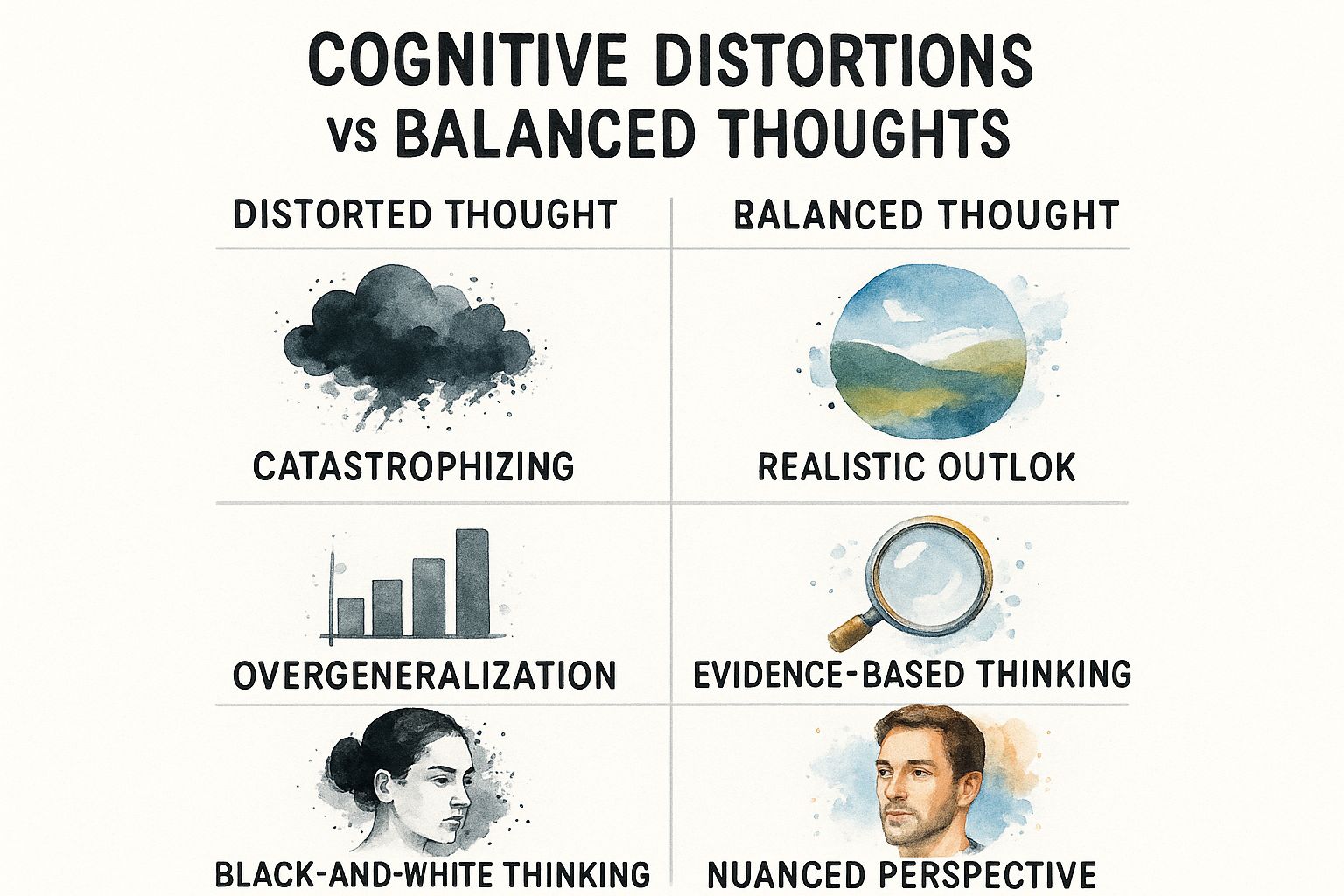
This visual contrast really highlights the power of perspective. The anxious thought is often an extreme, unproven conclusion, while the balanced thought is grounded in nuance and what's actually happening.
How to Challenge and Reframe Anxious Thoughts
Once you can spot a distorted thought, the next move is to challenge it. This isn't about getting into an argument with yourself. It's about asking genuine, curious questions to see if the thought actually holds up.
Let's say you feel a slight pain in your chest and your mind immediately screams, "I'm having a heart attack!" This is classic catastrophizing. Here’s how you can gently guide your mind back to safety:
- Ask for the evidence. What proof do I have that this is a heart attack? And what proof do I have that it isn't? (e.g., "I just had a huge coffee," "I'm not having any other key symptoms," or "I've felt this before and it turned out to be indigestion.")
- Look for other explanations. What else could this be? Maybe it's a muscle strain from the gym yesterday? Heartburn? Or just a momentary panic symptom I’ve felt before?
- Evaluate the real-world impact. What's the effect of believing this thought? It's causing panic and making everything worse. What would happen if I considered a more likely explanation? I could calm down and think about the situation more clearly.
Walking through this process guides your brain away from the panic button and toward a more realistic, manageable conclusion. You're literally creating new neural pathways—new ways of thinking that get stronger and more automatic every time you practice, leading you to a calmer future.
Calm Your Body and Regulate Your Nervous System
When anxiety spikes, it’s not just in your head. It’s a full-body experience. Your heart pounds, your breath gets shallow, and your muscles clench up like a fist. This is your nervous system slamming the pedal on its "fight-or-flight" mode—a primal survival response that’s incredibly draining in modern life.
Learning to consciously calm this physical storm is how you start taking your power back. It's about showing your body it’s safe, even when your mind is racing, and this is a skill you can learn.
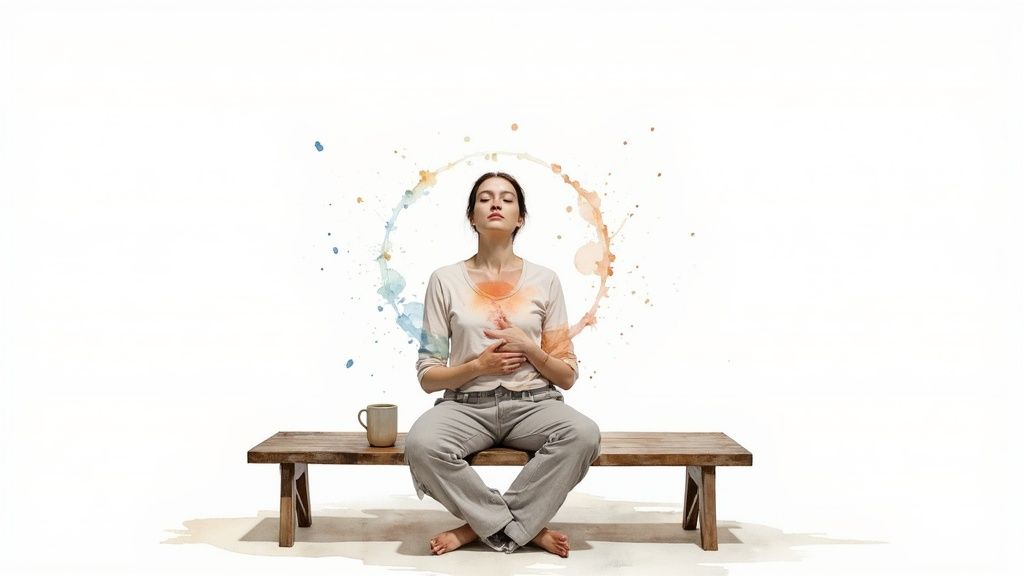
This process, called nervous system regulation, is one of the most tangible parts of learning to overcome anxiety without medication. Instead of feeling like a passenger during physical anxiety, you develop real skills to grab the steering wheel. It’s a profoundly hopeful shift toward feeling in control of your own body again.
Beyond Just a Deep Breath
You've probably been told to "take a deep breath" a million times. While the advice comes from a good place, it's often too vague to actually work when you're in the thick of it. For a moment of high anxiety, you need a more precise tool.
Enter the physiological sigh. Backed by neuroscience, this specific breathing pattern is designed to rapidly hit the brakes on your body's stress response. It works by quickly off-loading excess carbon dioxide and stimulating the vagus nerve, which is a key player in your "rest-and-digest" system.
Here’s the simple pattern:
- Take two quick, sharp inhales through your nose, one right after the other. Don't exhale in between.
- Then, let out a long, slow, extended exhale through your mouth.
That's it. Just one or two rounds can bring a noticeable wave of calm. The best part? It’s fast, effective, and subtle enough to do anywhere without anyone noticing. It’s an immediate tool you can use the second you feel anxiety start to creep in, reminding you that you always have a way to find calm. For a deeper dive, you can explore other breathing exercises for anxiety to build out your toolkit.
The Power of Consistent Movement
Movement is one of nature’s best anxiety regulators. When you're anxious, your body is flooded with stress hormones like cortisol and adrenaline, prepping you for a fight or a sprint. If you don't use that energy, it just stays trapped, fueling that awful feeling of restlessness and panic.
Think of gentle, consistent movement as a release valve. A daily walk, a yoga session, or even just dancing it out in your living room helps your body burn off that excess cortisol. At the same time, it boosts endorphins—your brain's natural feel-good chemicals that act as powerful mood elevators.
A brisk 30-minute walk can have the same calming effect as a mild tranquilizer for many people. Regular physical activity has been proven to decrease overall tension, stabilize mood, and improve sleep, creating a hopeful upward spiral of well-being.
You don't need to run a marathon. The magic is in the consistency. Aim for 20-30 minutes of moderate movement most days. Frame it as "anxiety maintenance" rather than "exercise"—a non-negotiable part of your routine for protecting your peace.
Releasing Physical Tension
Anxiety loves to hide out in the body as chronic muscle tension. Think clenched jaws, sky-high shoulders, and a stomach tied in knots. Actively releasing that tension sends a direct message to your brain: it's okay to relax now.
A classic and highly effective method for this is Progressive Muscle Relaxation (PMR). It’s a simple practice of systematically tensing and then releasing different muscle groups.
- How it works: Find a quiet place to sit or lie down. Start with your feet. Tense the muscles for five seconds, then release for 30 seconds, paying close attention to the feeling of letting go. Slowly work your way up your body: legs, abdomen, arms, and finally, your face.
- Why it works: PMR trains you to become acutely aware of the difference between tension and relaxation. With practice, you'll start noticing where you hold stress and can consciously release it before it builds into something overwhelming.
Exploring tools that help your body unwind can also be a game-changer. For instance, understanding the benefits of massage guns for physical relaxation can give you another way to directly tackle those physical symptoms, helping your muscles let go of stored-up stress.
Not sure which technique to try first? This table breaks down some of the most effective body-based calming methods to help you choose what fits your needs right now.
Body-Based Calming Techniques Compared
| Technique | Best For | How It Works |
|---|---|---|
| Physiological Sigh | Immediate panic relief | Quickly offloads CO2 and stimulates the vagus nerve to calm the fight-or-flight response. |
| Progressive Muscle Relaxation | Releasing chronic muscle tension | Teaches you to recognize and consciously release physical tension stored in the body. |
| Consistent Gentle Movement | Long-term nervous system regulation | Burns off stress hormones like cortisol and boosts mood-elevating endorphins. |
| Yoga or Tai Chi | Mind-body connection | Combines gentle movement, breathing, and mindfulness to reduce stress and improve awareness. |
Each of these tools works on a different timeline and for a different purpose, but they all share a common goal: helping you feel more at home and safe in your own body.
By focusing on these physical techniques, you’re doing more than just coping with symptoms. You're fundamentally retraining your physiological response to stress. You are teaching your nervous system a new, calmer way to exist in the world.
Embrace Grounding Practices for Present-Moment Awareness
Anxiety has a sneaky way of hijacking your mind, dragging it into worries about the future or regrets about the past. It pulls you everywhere except the one place you actually are: the present moment.
Grounding and mindfulness are your anchors back to the now. Think of them as a safe harbor where panic and worry have far less power. This isn't about forcing your mind to go blank; it’s about learning to notice your thoughts without getting swept away by them, proving you are stronger than your anxiety.
This practice creates a tiny, precious space between an anxious trigger and your usual reaction. In that space, you find your power. You discover that you can choose a calmer response, finally breaking the cycle that keeps you feeling stuck and paving the way for a more peaceful life.
The Power of Sensory Focus
When panic starts to rise, your mind can feel like it's spinning completely out of control. The fastest way to get your footing back is to pull your focus out of your head and into your physical senses. That's the heart of grounding.
It works because your brain can't simultaneously spiral into catastrophic "what-if" scenarios while also paying close attention to the world right in front of you.
One of the most effective and easy-to-learn methods is the 5-4-3-2-1 technique. It forces your brain to engage with your immediate environment, which effectively short-circuits the anxiety loop.
Here's how it works:
- 5 Things You Can See: Look around and name five things. A blue pen, a crack on the ceiling, a spinning fan. Notice the details without judgment.
- 4 Things You Can Touch: Feel four things around you. The soft fabric of your shirt, the cool smoothness of the desk, the rough texture of your jeans.
- 3 Things You Can Hear: Listen closely and identify three distinct sounds. The hum of your computer, birds chirping outside, your own steady breath.
- 2 Things You Can Smell: What are two scents you can pick up on? The faint smell of coffee, the soap on your hands.
- 1 Thing You Can Taste: Focus on one thing you can taste, even if it's subtle. The lingering mint from your toothpaste or just a simple sip of water.
This simple exercise is a powerful reminder that you are safe in the present moment. By focusing your attention on your senses, you prove to yourself that you are in control—not the anxiety. If you want to explore more options, there are many powerful grounding techniques for anxiety that you can add to your mental toolkit.
Changing Your Relationship with Anxiety
A core part of mindfulness is learning to observe your anxious thoughts and feelings from a distance, rather than getting tangled up in them.
Imagine your thoughts are just clouds passing in the sky. You can notice them, acknowledge them ("There's that anxious thought again"), and then just let them drift by without having to chase after them.
This changes everything. You begin to see that anxiety is a temporary visitor, not a permanent part of who you are.
A five-minute body scan is a great way to put this into practice. Simply lie down, close your eyes, and bring a gentle, non-judgmental attention to each part of your body, from your toes all the way up to your head. You're not trying to fix anything; you're just noticing the sensations. This reconnects you with your physical self, breaking that mental loop of worry.
Mindfulness-based practices aren't just a hopeful theory; they are a scientifically validated path to healing. They teach you that you are the sky, not the storm clouds.
The effectiveness of this approach is backed by some pretty compelling research. In one notable trial, Mindfulness-Based Stress Reduction (MBSR) was directly compared to a common anti-anxiety medication. The study discovered that MBSR was just as effective at reducing anxiety symptoms, proving it to be a powerful, non-drug approach to healing.
This research offers incredible hope for anyone looking to overcome anxiety without medication. You can read the full research about these mindfulness findings on JAMA Psychiatry. This isn't just about coping; it's about fundamentally changing your brain for the better, paving the way for a panic-free life.
Build a Lifestyle That Protects Your Peace
True, lasting relief from anxiety isn't just about managing panic in the moment. It's about building a life that naturally protects your peace. The small, consistent choices you make every day create a powerful foundation that makes you more resilient to stress. This is where you shift from reacting to anxiety to proactively building a life where peace is your default state.
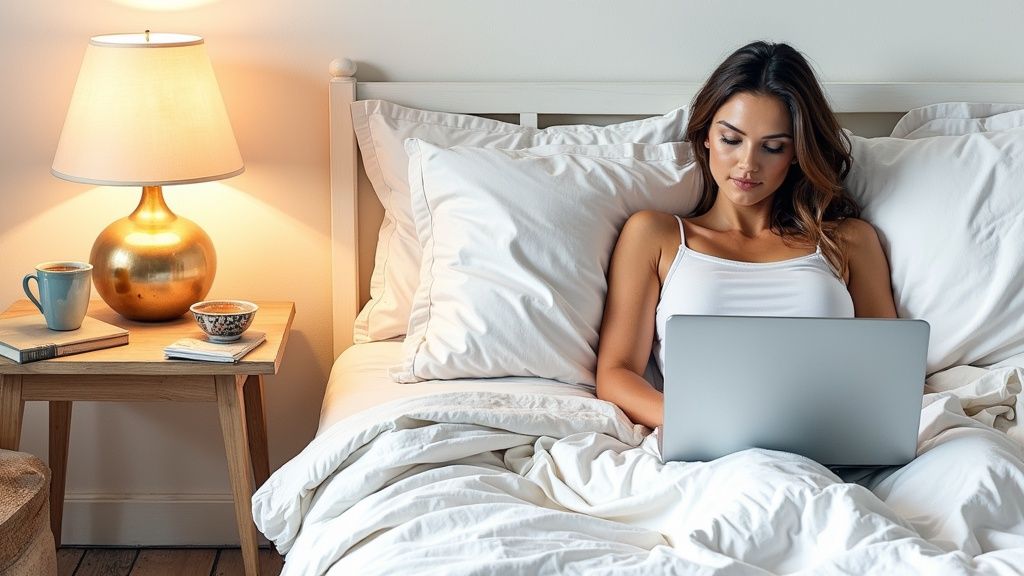
Think of it like building a fortress. Each healthy habit is another stone in the wall, making you stronger and safer. This approach is fundamental to learning how to overcome anxiety without medication because it addresses your well-being from the ground up, creating stability from the inside out.
Master Your Sleep to Master Your Mood
Sleep and anxiety are locked in a frustrating cycle. Anxiety keeps you up at night, and a lack of sleep leaves you raw and vulnerable to anxiety the next day. It’s no surprise that research consistently shows sleep difficulties are incredibly common alongside anxiety disorders. Breaking this cycle is not just possible, it's one of the most powerful steps you can take toward healing.
Creating a solid sleep routine, often called sleep hygiene, trains your brain to recognize when it’s time to wind down. This isn't just about having a bedtime; it's about creating a calming ritual that signals safety to your nervous system.
Here are a few high-impact strategies to get you started:
- Create a Tech-Free Zone: That blue light from your phone is no joke—it messes with your body's natural sleep-wake cycle. Make your bedroom a screen-free sanctuary for at least an hour before you plan to sleep.
- Set a Consistent Wake-Up Time: Yes, even on weekends. Waking up around the same time every day helps regulate your internal clock, which in turn makes it much easier to fall asleep at night.
- Develop a Wind-Down Ritual: This could be reading a physical book, listening to calm music, or doing some gentle stretching. The activity itself matters less than its consistency.
Simply prioritizing sleep is a profound act of self-care. It tells your body and mind that rest is a priority, which in itself can lower the baseline level of stress you carry around all day.
"Your future self is created by the habits you build today. A calm mind tomorrow is built on the peaceful sleep you get tonight."
Fuel Your Body to Calm Your Mind
What you eat has a direct and powerful impact on your mood and anxiety levels. When you’re feeling anxious, it's so easy to reach for sugary snacks or another cup of coffee for a quick boost. But these often lead to a nasty energy crash that can make anxiety feel even worse. The goal here is stability.
A balanced diet helps regulate your blood sugar, preventing the sharp spikes and dips that can mimic or even trigger anxiety symptoms. Your gut health is also a huge player here. Did you know a significant portion of your body's serotonin—a key mood-regulating neurotransmitter—is actually produced in your gut?
To get into the specifics of crafting a supportive diet, check out our in-depth guide covering the essential lifestyle and diet changes for anxiety management. It's packed with practical tips for nourishing your body in a way that directly supports your mental health.
The Power of Setting Boundaries
In our hyper-connected world, it's easy to feel like you're "on" 24/7. This constant drain on your mental and emotional energy is a massive driver of anxiety. Setting boundaries is not selfish; it is an essential practice for protecting your peace and reclaiming your life.
Boundaries are simply the limits you set to protect your own well-being. They can show up in all sorts of areas in your life:
- Work: This might look like not checking emails after 6 p.m. or learning to say "no" to extra projects when your plate is already full.
- Technology: Set specific times to put your phone away. The constant stream of notifications keeps your nervous system in a state of high alert.
- People: It's absolutely okay to decline social invitations when you feel drained. It's also okay to limit your time with people who consistently leave you feeling stressed or exhausted.
Learning to set and maintain boundaries is a skill. It can feel really uncomfortable at first, especially if you're a people-pleaser. But it is one of the most empowering things you can do for your mental health. Each boundary you set is a clear message to yourself that your peace is worth protecting.
Your Questions on Natural Anxiety Relief Answered
Deciding to heal from anxiety without medication is a huge step, but it almost always comes with a flood of questions. That’s completely normal. Feeling a little uncertain is just part of the process, and I want to give you some clear, honest answers to the concerns I hear most often.
My goal is to help you feel confident and genuinely hopeful as you start this journey. Knowledge is power here. When you understand the why and how behind these methods, it reinforces the message that you absolutely can regain control and build a calmer, panic-free life.
How Long Does It Take to See Results?
This is probably the first question on everyone's mind, and for good reason. Unlike some medications that can bring changes within weeks, natural methods work more like building a muscle. It’s a gradual process where small efforts compound over time into profound change.
Some tools, like the physiological sigh or a quick grounding exercise, can offer immediate relief right in the middle of a panic spike. Think of them as your emergency brakes.
But the deeper, more permanent changes—the kind that come from consistently practicing cognitive reframing and mindfulness—take longer to become your new default setting. You might notice small wins within a few weeks, like catching a catastrophic thought before it sends you spiraling. Real, lasting change in your day-to-day anxiety levels often takes a few months of dedicated practice.
The secret ingredients are consistency and self-compassion. This isn't a sprint to a finish line. It’s about building an entirely new, stronger foundation for your mental health. Every single time you use a new skill, you are literally carving out and strengthening a calmer neural pathway in your brain.
Can I Really Overcome Severe Anxiety or Panic Attacks Without Medication?
Yes, for many people, it is absolutely possible to heal from—and even overcome—severe anxiety and panic attacks using these approaches. The techniques in this guide aren't just feel-good suggestions; they are evidence-based strategies that get to the root of what fuels anxiety.
Methods based on CBT and mindfulness are often considered first-line treatments for anxiety disorders. They work by fundamentally changing your relationship with the thoughts and physical sensations that trigger panic, rather than just masking the symptoms. You're building lifelong skills, not just applying a temporary fix.
While it's a path that requires real commitment, these tools empower you with a toolkit that's always with you. But "without medication" should never mean "without support." Working with a qualified therapist who specializes in these techniques can be a game-changer, especially when you're dealing with severe symptoms. If you want to explore more structured options, you might find it helpful to look into the various naturopathic treatments for anxiety.
The ultimate goal is to build your own internal sense of safety and control so panic is no longer in the driver's seat. A life free from panic is achievable.
What If I Try These Techniques and They Don't Work?
It's so easy to feel discouraged when a new technique doesn't click right away. Please know this isn't a sign that you've failed. It's just feedback that you may need to tweak your approach, and that is perfectly okay. This is a journey of discovery.
First off, not every single strategy works for every single person. The beauty of this approach is that it’s a toolkit, not a rigid prescription. If sitting down for formal meditation feels like torture, maybe a mindful walk or a calming yoga flow is a much better fit for your nervous system. The whole point is to experiment and find the unique mix of tools that resonates with you.
Second, consistency really is everything. These are skills. Just like learning to play the guitar, they take regular practice to become effective and feel natural. If you've given it an honest, consistent shot for a few months and still feel stuck, seeking professional support is a sign of incredible strength, not weakness.
A good therapist can help tailor these strategies specifically to your situation, uncover any underlying roadblocks, and provide the accountability that can make all the difference. The journey to healing is almost never a straight line. There is always hope, and there is always another way forward.
At The Anxiety Checklist, we believe everyone deserves to live a life free from the grip of panic. Our Fearless Living: Beat Anxiety and Live Your Best Life program is a complete system designed by a 15-year anxiety survivor to give you the exact tools you need. It combines a practical eBook with an interactive 93-point checklist to help you build a personalized plan for lasting relief. Start your journey to a more fearless life today.

